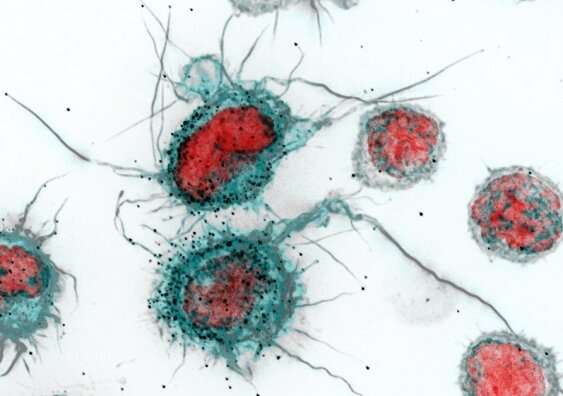This article has been reviewed according to Science X's editorial process and policies. Editors have highlighted the following attributes while ensuring the content's credibility:
fact-checked
trusted source
proofread
HIV diagnoses in Australia remained low in 2022

Despite disruptions to testing and risk behavior during COVID-19, the latest data from UNSW Sydney's Kirby Institute shows Australia is tracking well toward the elimination of HIV transmission.
HIV diagnoses in Australia have halved over the last decade, and have remained stable over the past year, with 555 diagnoses in 2022, according to new data by the Kirby Institute at UNSW Sydney.
"The 2022 data show that Australia is tracking well toward the elimination of HIV transmission," says Dr. Skye McGregor, head of the Surveillance Innovation Research Group at the Kirby Institute.
"We can see the impact of prevention strategies like increasing HIV testing, treatment as prevention, and pre-exposure prophylaxis particularly among gay and bisexual men, for whom new diagnoses have been dropping significantly since 2014."
The data were released just ahead of the 12th IAS Conference on HIV Science, hosted by the International AIDS Society in Brisbane and virtually. They show that the majority (57%) of new HIV cases continue to be diagnosed among gay and bisexual men. However, diagnoses among this group have halved over the past 10 years. Diagnoses in heterosexuals accounted for 30% of all diagnoses in 2022.
"These data suggest that to eliminate HIV, there needs to be increasing focus on prevention strategies that encompass all populations, including heterosexual men and women, particularly as we all begin to travel more following the relaxing of COVID-19 control measures. This includes safe sex travel campaigns and regular sexual health checks ups which include HIV testing," says Dr. McGregor.
From 2021 to 2022 there were some small increases in the number of diagnoses among heterosexual people, Aboriginal and Torres Strait Islander peoples, and in some states and territories, but the researchers say we need to be cautious in the interpretation of these increases.
"Australia really is in an incredible position in our response to HIV. We've had a few years now of HIV diagnoses below 1,000, and when the numbers are this low, we will likely see small year-on-year fluctuations, particularly in sub-groups," says Dr. McGregor.
"Another really important factor impacting these figures is testing. We know that HIV testing decreased during the COVID pandemic, so it is very possible that our HIV numbers during COVID-19 were related to fewer tests, and that the increase over the past year reflects a return to face-to-face health care and regular testing."
In 2022, 44% of HIV diagnoses were classified as late, which means the person diagnosed may have been living with HIV for four or more years without knowing their HIV status and may be experiencing HIV-related illness.
"The number of late diagnoses is concerning and should serve as a timely reminder that anyone who is sexually active should have regular sexual health checkups, including a test for HIV," says Dr. McGregor.
"In order to continue our world-leading response to HIV, we need to increase access to testing, treatment and prevention equitably, across all areas of need," she says.
The federal Minister for Health and Aged Care, Mark Butler, says the data shows our targets for the elimination of HIV transmission are achievable, but we cannot afford to be complacent.
"I welcome the release of this data and thank the Kirby Institute for its ongoing contribution to the fight against HIV.
"The Australian government will continue to work closely with community organizations, health departments and research centers like the Kirby Institute, to maintain Australia's position as a world leader in HIV elimination," he says.
Australia's world-leading HIV reductions in gay and bisexual men
Australia has achieved a remarkable 57% reduction in new HIV diagnoses among gay and bisexual men since 2013, showcasing the success of comprehensive approaches to HIV prevention within this population.
"The reductions in HIV diagnoses over the past decade came after years of increases among this group," says Professor Andrew Grulich, who leads the HIV Epidemiology and Prevention Program at the Kirby Institute.
"They showed the success of community-led health promotion strategies, and of scientific discoveries like treatment as prevention. Treatment as prevention, or U = U, is the finding that a HIV positive partner on effective HIV treatment cannot transmit the virus to a negative partner. From 2016, with the rollout of PrEP—a pre-exposure prophylaxis medication that prevents HIV infection—we saw HIV diagnoses decline even more rapidly."
The reductions among this group have continued in 2022, even in the context of lower diagnoses in 2020 and 2021 that may have been related to reduced testing during COVID-19 social restrictions.
"These ongoing reductions are a result of the partnership response to HIV in Australia, which involves ongoing coordination of important contributions of communities, clinicians, government, and researchers. Australia brings these contributions together better than anywhere else in the world, and the numbers today are evidence of our collective success," says Prof Grulich.
HIV diagnoses among Aboriginal and Torres Strait Islander peoples
HIV diagnoses among Aboriginal and Torres Strait Islander peoples have increased over the past year, with 25 diagnoses in 2022. Robert Monaghan, Manager of Aboriginal and Torres Strait Islander Health research at the Kirby Institute says although numbers are low compared to the general population, any increase among this population is concerning.
"We know that Aboriginal and Torres Strait Islander people face additional barriers to accessing prevention and care. People in rural and remote communities were also more likely to have their regular health activities impacted by the COVID-19 pandemic. Co-designed campaigns rolled out in partnership with local community organizations are needed, focused on testing, treatment, and PrEP," he says.





















